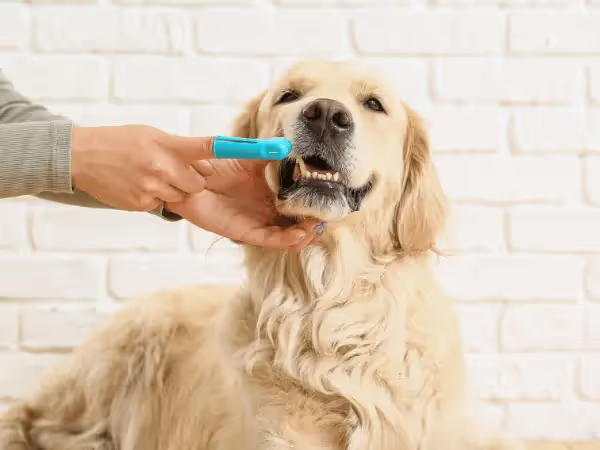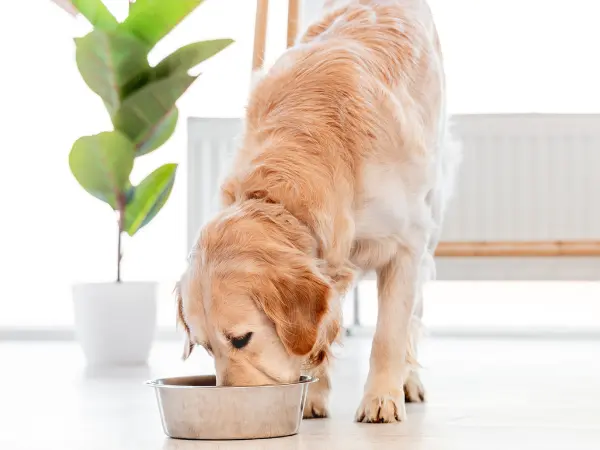Just like humans, dogs are prone to plaque buildup, gum disease, and painful infections if their teeth aren’t cared for regularly. Therefore, teeth cleaning or toothbrushing is an important part of your dog’s routine care.
Learning how to brush a dog’s teeth or how to clean a dog’s teeth with gauze at home can help prevent dental issues and keep your pup’s smile as healthy as can be.
This Sploot Vets guide explores the best ways to clean a dog’s teeth, and when to seek veterinary dental care.
Overview of How to Clean a Dog’s Teeth:
- To clean a dog’s teeth at home, you can use either a toothbrush or a gauze pad.
- Most dogs can be trained to be cooperative while toothbrushing. In most cases, puppies are easier to train; however, most dogs can be successfully trained with the use of positive reinforcement.
- While at-home dental care for dogs is important, it is NOT meant to replace yearly veterinary dental care and teeth cleaning.
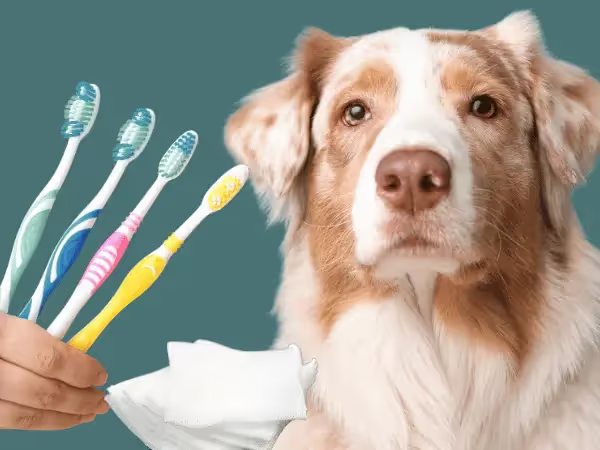
Is Brushing A Dog’s Teeth Necessary?
Yes—brushing a dog’s teeth is very necessary. Ideally, pet parents should brush their dog’s teeth daily. At the very least, aim for three times a week. Consistent brushing helps prevent tartar buildup, gingivitis, and other dental issues in dogs.
What Is the Most Effective Way to Clean a Dog's Teeth?
The most effective way to clean a dog’s teeth is by toothbrushing with an enzymatic dog toothpaste. This method removes plaque before it hardens into tartar. If brushing isn’t an option, the next best way to clean a dog’s teeth at home is by using gauze wrapped around your finger.
Other additional tools for at-home dental care for dogs include:
- Dental chews or treats for dogs – These can help scrape away soft plaque while satisfying your dog’s chewing instincts.
- Dental water additives for dogs – These are special formulas added to your dog’s drinking water to help reduce bacteria and freshen their breath.
Note: Dental treats and water additives for dogs are not intended to replace brushing or cleaning the dog’s teeth. When choosing dental treats and water additives for dogs, refer to the Veterinary Oral Health Council’s list to choose products that are effective against plaque and/or tartar.
A. How to Brush a Dog’s Teeth
Getting a Dog-Friendly Toothbrush
Typically, toothbrushes for dogs are smaller than human toothbrushes, with soft bristles for a gentle clean. These toothbrushes for dogs are typically one of the following:
- Handheld toothbrushes for dogs – these feature angled bristles to facilitate easy toothbrushing.
- Finger brushes – another type of dog toothbrush; they fit over the finger for comfortable usage. (This is typically best for beginners.)
Note: In instances where dog-friendly toothbrushes are difficult to find, Sploot veterinarian Dr. Sylvia Berns offers this tip: “If the pet parent is looking to purchase a human toothbrush instead (which may be easier to find in some cases), we recommend getting one for kids or pediatric toothbrushes as these are smaller and have softer bristles.”
Choosing a Dog-Friendly Toothpaste
Dog-friendly toothpastes are specifically formulated for dogs, excluding any ingredients that are unsafe for them (e.g., xylitol), which are sometimes present in human toothpaste.
Some toothpastes for dogs are enzymatic, featuring special enzymes to help break down plaque and harmful bacteria; these are typically recommended by veterinarians for a more thorough clean.
Many dog toothpastes are also flavored to taste like beef, chicken, or peanut butter, making brushing more enjoyable for dogs.
Steps on How to Brush a Dog’s Teeth
Once you have everything you need, you can start training your dog to be cooperative while toothbrushing. This can be done at any point; however, it’s best to get your dog started on toothbrush training as soon as possible. Puppies are generally easier to train, but with patience and consistency, most older dogs can also be trained.
Here are the steps on how to brush your dog’s teeth. This is considered the best way to clean a dog’s teeth at home:
Note: Take your time with each step. For both puppies and adult dogs, each of these steps can take several days. Only proceed to the next step once your dog is comfortable with the current step.
- Get your dog accustomed to being touched near the mouth. Whenever your dog responds calmly, reward them with dental treats and/or praise. Once your dog is comfortable with this step, move on to the next one.
- Introduce the dog toothpaste to your dog. Since many dog toothpastes are flavored, this can be an enjoyable step for many dogs. Reward your dog with plenty of praise when they respond calmly or positively.
- Practice holding your dog comfortably for toothbrushing. It’s best to be on the same level as your dog, facing the same direction as them (not facing them head-on), and have an arm around them to prevent them from scooting backwards. Hold your dog while also gently touching near their mouth. Reward calm behavior.
- Once your dog is comfortable with being held and having their mouth area touched, introduce the dog toothbrush. Allow them to lick flavored toothpaste or treats from it to help them form a positive association with the toothbrush.
- Next, begin toothbrushing. Focus on the canine teeth first (the long, sharp front teeth). This helps your dog get used to the sensation of having their teeth brushed. The canines are easily accessible, making them a great starting point.
- After several days of brushing just your dog’s canines, take the next step: hold your dog securely (as in step 3) and lift their lip to brush their molars briefly. Try to brush the molars on both sides of the mouth for just a few seconds to start.
- Gradually increase your dog’s toothbrushing time. Slowly build up to 30 seconds per side. When your dog is calm and cooperative, give them plenty of praise and/or some dental treats.
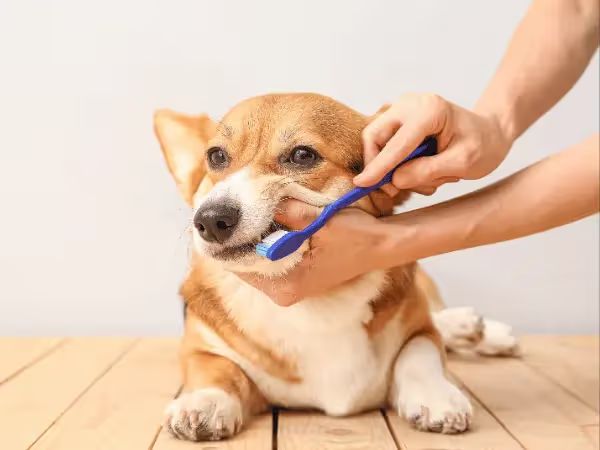
B. How To Clean A Dog’s Teeth Without Brushing [Using Gauze]
For some dogs, toothbrushing can be really difficult, especially for older or more anxious dogs. If this sounds like your dog, you can try another method for cleaning a dog’s teeth using gauze. This is the second-best way to clean a dog’s teeth at home.
Here are the steps on how to clean a dog’s teeth using gauze:
Note: Some of these steps overlap with the steps for brushing a dog’s teeth, because the general principle of positive reinforcement is the same. Similarly, each step can also take several days. Only proceed to the next step once your dog is comfortable with the current step.
- Get your dog accustomed to being touched near the mouth. Each time they stay calm, reward them with praise or a dental treat. Once they’re comfortable with this step, you can move forward.
- Practice holding your dog in a secure but gentle way for at-home teeth cleaning. Position yourself at the same level as your dog, facing the same direction (rather than head-on). Place one arm gently around them to prevent them from backing away, while lightly touching near their mouth. Reward calm behavior.
- When your dog is at ease with handling, it’s time to try using the gauze to clean their teeth. Take a clean, non-woven 3x3 gauze and wrap it around your index finger.
- Hold your dog (as in step 2), and use the gauze to gently rub their canine teeth (the long, pointed teeth at the front). These teeth are the easiest to reach, making them the best starting point. Watch your dog’s reaction closely and reward calm behavior with praise or a small dental treat.
- After several days of cleaning just the canine teeth with gauze, progress to lifting your dog’s lip gently and giving their molars quick swipes on each side as well.
- As your dog becomes more comfortable with the previous step, progress to doing 4–5 thorough swipes on each side of their mouth.
Note: Once your dog is comfortable with steps 1 to 6, you can try adding some enzymatic toothpaste to the gauze for a deeper clean.
In the following video, Sploot Medical Director Dr. Veronica Cruz demonstrates how to clean a dog’s teeth using gauze:
Note: Dog teeth cleaning with a gauze may not be as thorough as toothbrushing, but it’s still a helpful option for maintaining your dog’s oral hygiene. Additionally, if your dog becomes accustomed to gauze cleaning, you can introduce toothbrushing using a finger brush later on.
When Should A Dog's Teeth Be Cleaned By a Vet?
Even with the best at-home care, dogs need routine professional dental cleanings. Veterinary teeth cleaning for dogs removes hardened tartar and plaque. In some cases, teeth cleaning for dogs is performed before their dental exam to provide a more thorough examination of the dog’s teeth.
Note: At Sploot Vets, we pair dental cleaning for dogs with state-of-the-art technology for performing dental exams, including full-mouth probing and X-rays, to thoroughly assess a dog’s dental health above and below the gumline. Our thorough approach allows us to detect dental diseases or abnormalities that anesthetic-free cleanings can miss. Learn more about our dental care services here →
Most dogs need this procedure at least once or twice a year, but your vet may recommend it more often depending on your dog’s breed, age, and oral health.
Final Thoughts on How to Clean or Brush a Dog’s Teeth
This concludes our guide on how to brush a dog’s teeth and how to clean a dog’s teeth with gauze. Regular at-home dental care is key to preventing painful dental diseases in dogs.
Toothbrushing is the best way to clean a dog’s teeth, but wiping with a gauze is the next best method. Additionally, dental chews and water additives can also be beneficial. Lastly, at-home care should be paired with routine veterinary dental exams and professional teeth cleanings for dogs.
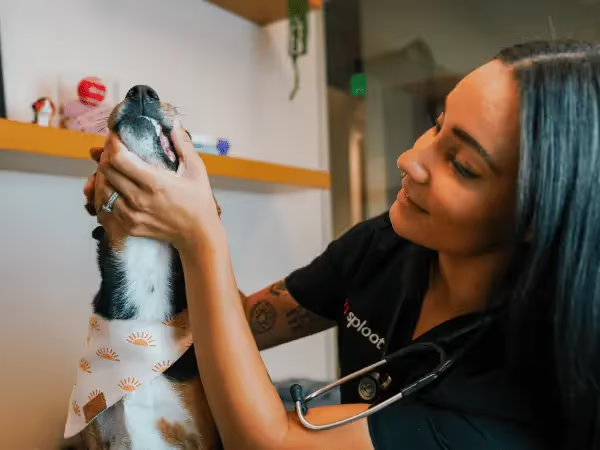
Sploot Vets: Your All-in-One Vet, Including Canine Dental Care
At Sploot Vets, we provide all-in-one veterinary care, including dental care for dogs, as well as preventative care, urgent care, and emergency vet services—all under one woof™!
Additionally, we prioritize your pet’s well-being with our Fear Free vet care approach. We ensure that vet visits are as comfortable as possible, especially for anxious dogs, puppies, and senior dogs.
With clinics in Chicago, Denver, and Colorado Springs, we’re here for you 365 days a year with extended hours.
Easily schedule your appointment online or through the Sploot Vets pet care app.


